Analyzing the Influence of Age on Depth of Processing Effects
VerifiedAdded on 2023/06/14
|14
|3130
|320
Report
AI Summary
This report investigates the influence of age on the depth of processing effects on memory recall, utilizing reworked data from a study by Howell (2013). The study included 100 participants divided into two age groups: 18-30 and 55-65. Statistical tests, including ANOVA and correlational analysis, were applied to assess differences in recollection ability between younger and older participants, as well as the relationship between age and recall power. The results indicated a significant difference in recollection ability between the two age groups, with older participants requiring more time to recall texts. The study also found a weak negative correlation between age and recalling power, suggesting that recall ability decreases with age. Normality tests were conducted, revealing violations of normality assumptions for the recollection variable. Regression analysis further supported that age could explain a small percentage of the variability in recalling power. An independent sample t-test confirmed significant differences in recalling powers between the younger and older groups, highlighting the impact of age on memory recall.
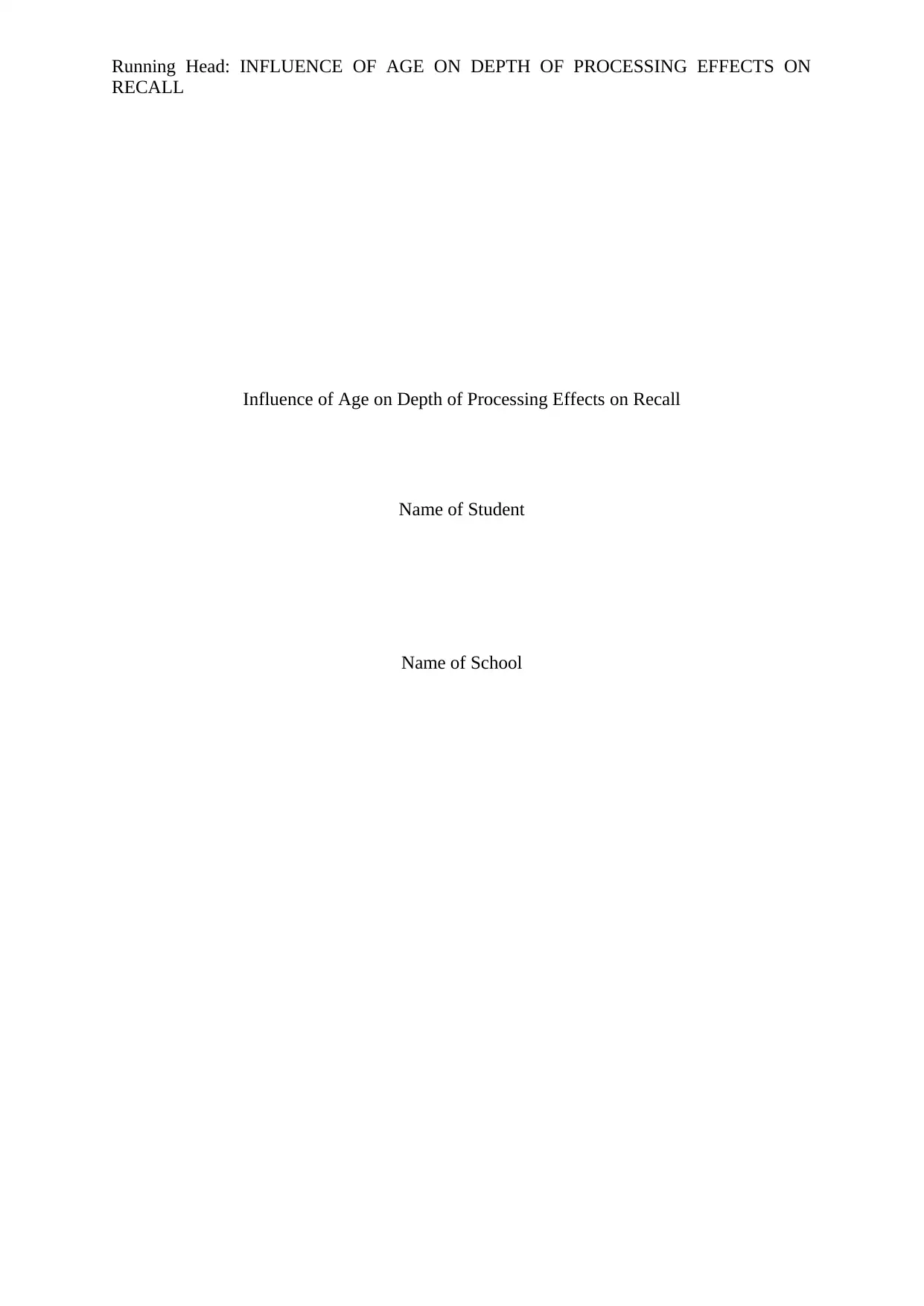
Running Head: INFLUENCE OF AGE ON DEPTH OF PROCESSING EFFECTS ON
RECALL
Influence of Age on Depth of Processing Effects on Recall
Name of Student
Name of School
RECALL
Influence of Age on Depth of Processing Effects on Recall
Name of Student
Name of School
Paraphrase This Document
Need a fresh take? Get an instant paraphrase of this document with our AI Paraphraser
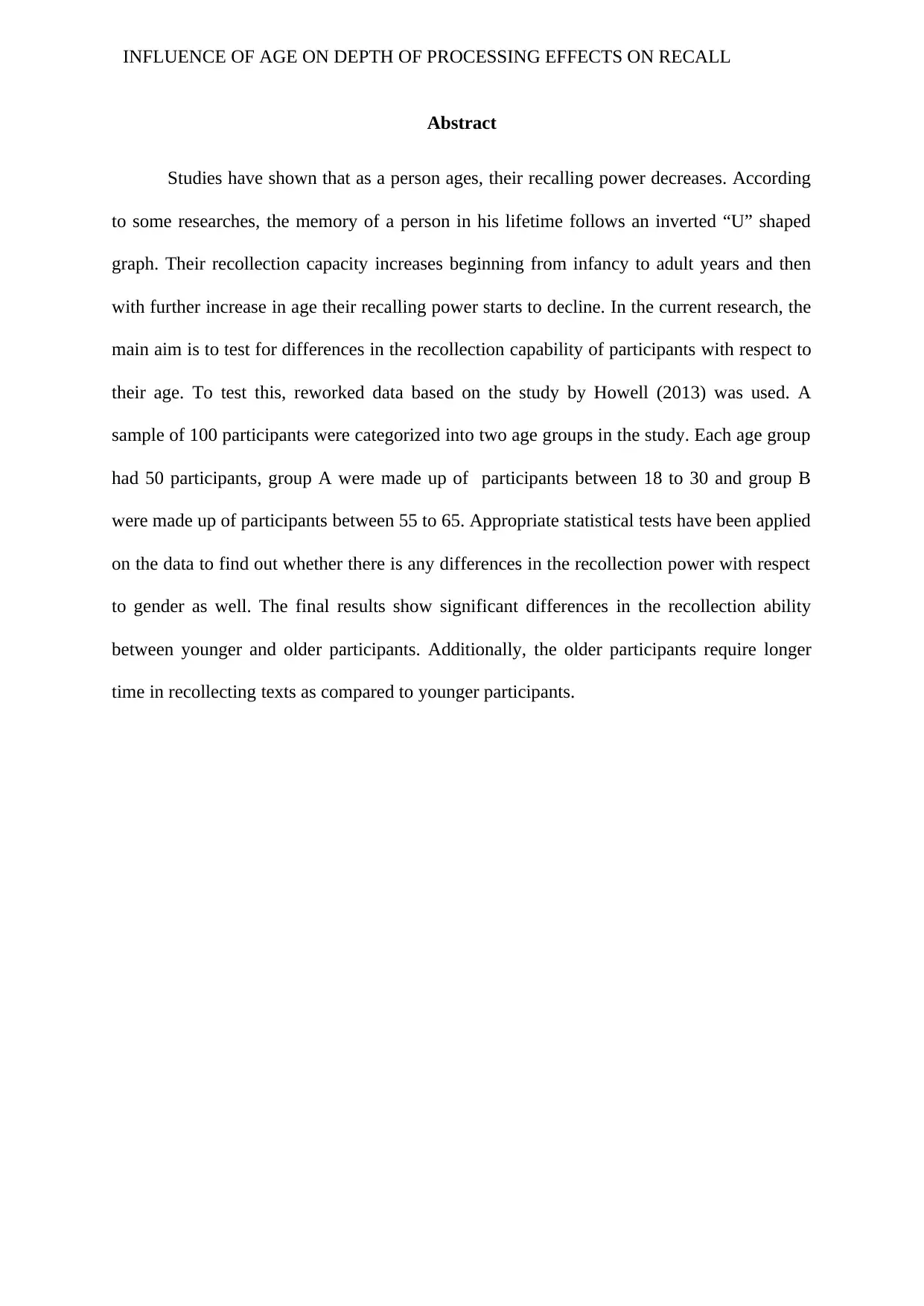
INFLUENCE OF AGE ON DEPTH OF PROCESSING EFFECTS ON RECALL
Abstract
Studies have shown that as a person ages, their recalling power decreases. According
to some researches, the memory of a person in his lifetime follows an inverted “U” shaped
graph. Their recollection capacity increases beginning from infancy to adult years and then
with further increase in age their recalling power starts to decline. In the current research, the
main aim is to test for differences in the recollection capability of participants with respect to
their age. To test this, reworked data based on the study by Howell (2013) was used. A
sample of 100 participants were categorized into two age groups in the study. Each age group
had 50 participants, group A were made up of participants between 18 to 30 and group B
were made up of participants between 55 to 65. Appropriate statistical tests have been applied
on the data to find out whether there is any differences in the recollection power with respect
to gender as well. The final results show significant differences in the recollection ability
between younger and older participants. Additionally, the older participants require longer
time in recollecting texts as compared to younger participants.
Abstract
Studies have shown that as a person ages, their recalling power decreases. According
to some researches, the memory of a person in his lifetime follows an inverted “U” shaped
graph. Their recollection capacity increases beginning from infancy to adult years and then
with further increase in age their recalling power starts to decline. In the current research, the
main aim is to test for differences in the recollection capability of participants with respect to
their age. To test this, reworked data based on the study by Howell (2013) was used. A
sample of 100 participants were categorized into two age groups in the study. Each age group
had 50 participants, group A were made up of participants between 18 to 30 and group B
were made up of participants between 55 to 65. Appropriate statistical tests have been applied
on the data to find out whether there is any differences in the recollection power with respect
to gender as well. The final results show significant differences in the recollection ability
between younger and older participants. Additionally, the older participants require longer
time in recollecting texts as compared to younger participants.
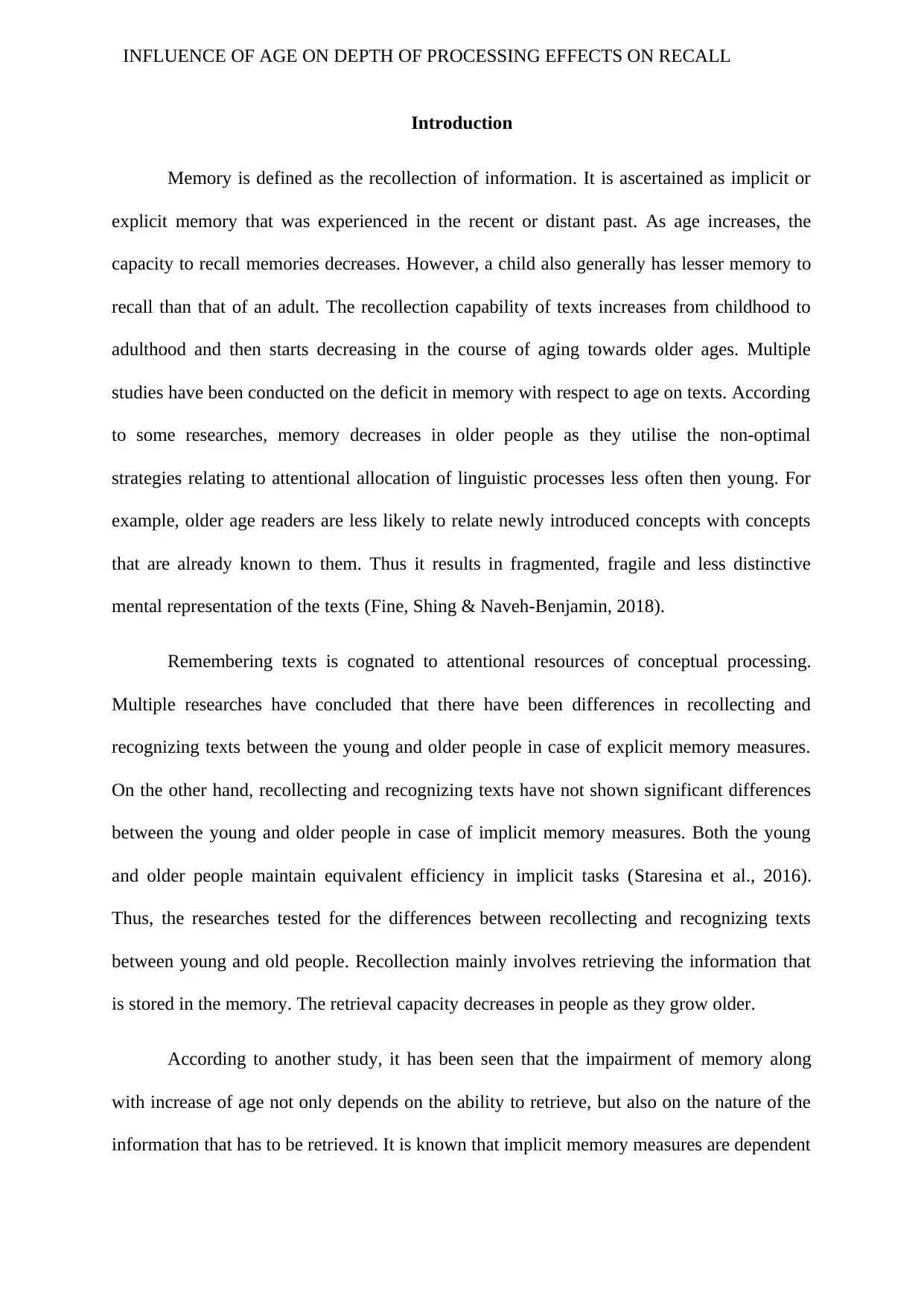
INFLUENCE OF AGE ON DEPTH OF PROCESSING EFFECTS ON RECALL
Introduction
Memory is defined as the recollection of information. It is ascertained as implicit or
explicit memory that was experienced in the recent or distant past. As age increases, the
capacity to recall memories decreases. However, a child also generally has lesser memory to
recall than that of an adult. The recollection capability of texts increases from childhood to
adulthood and then starts decreasing in the course of aging towards older ages. Multiple
studies have been conducted on the deficit in memory with respect to age on texts. According
to some researches, memory decreases in older people as they utilise the non-optimal
strategies relating to attentional allocation of linguistic processes less often then young. For
example, older age readers are less likely to relate newly introduced concepts with concepts
that are already known to them. Thus it results in fragmented, fragile and less distinctive
mental representation of the texts (Fine, Shing & Naveh-Benjamin, 2018).
Remembering texts is cognated to attentional resources of conceptual processing.
Multiple researches have concluded that there have been differences in recollecting and
recognizing texts between the young and older people in case of explicit memory measures.
On the other hand, recollecting and recognizing texts have not shown significant differences
between the young and older people in case of implicit memory measures. Both the young
and older people maintain equivalent efficiency in implicit tasks (Staresina et al., 2016).
Thus, the researches tested for the differences between recollecting and recognizing texts
between young and old people. Recollection mainly involves retrieving the information that
is stored in the memory. The retrieval capacity decreases in people as they grow older.
According to another study, it has been seen that the impairment of memory along
with increase of age not only depends on the ability to retrieve, but also on the nature of the
information that has to be retrieved. It is known that implicit memory measures are dependent
Introduction
Memory is defined as the recollection of information. It is ascertained as implicit or
explicit memory that was experienced in the recent or distant past. As age increases, the
capacity to recall memories decreases. However, a child also generally has lesser memory to
recall than that of an adult. The recollection capability of texts increases from childhood to
adulthood and then starts decreasing in the course of aging towards older ages. Multiple
studies have been conducted on the deficit in memory with respect to age on texts. According
to some researches, memory decreases in older people as they utilise the non-optimal
strategies relating to attentional allocation of linguistic processes less often then young. For
example, older age readers are less likely to relate newly introduced concepts with concepts
that are already known to them. Thus it results in fragmented, fragile and less distinctive
mental representation of the texts (Fine, Shing & Naveh-Benjamin, 2018).
Remembering texts is cognated to attentional resources of conceptual processing.
Multiple researches have concluded that there have been differences in recollecting and
recognizing texts between the young and older people in case of explicit memory measures.
On the other hand, recollecting and recognizing texts have not shown significant differences
between the young and older people in case of implicit memory measures. Both the young
and older people maintain equivalent efficiency in implicit tasks (Staresina et al., 2016).
Thus, the researches tested for the differences between recollecting and recognizing texts
between young and old people. Recollection mainly involves retrieving the information that
is stored in the memory. The retrieval capacity decreases in people as they grow older.
According to another study, it has been seen that the impairment of memory along
with increase of age not only depends on the ability to retrieve, but also on the nature of the
information that has to be retrieved. It is known that implicit memory measures are dependent
⊘ This is a preview!⊘
Do you want full access?
Subscribe today to unlock all pages.

Trusted by 1+ million students worldwide
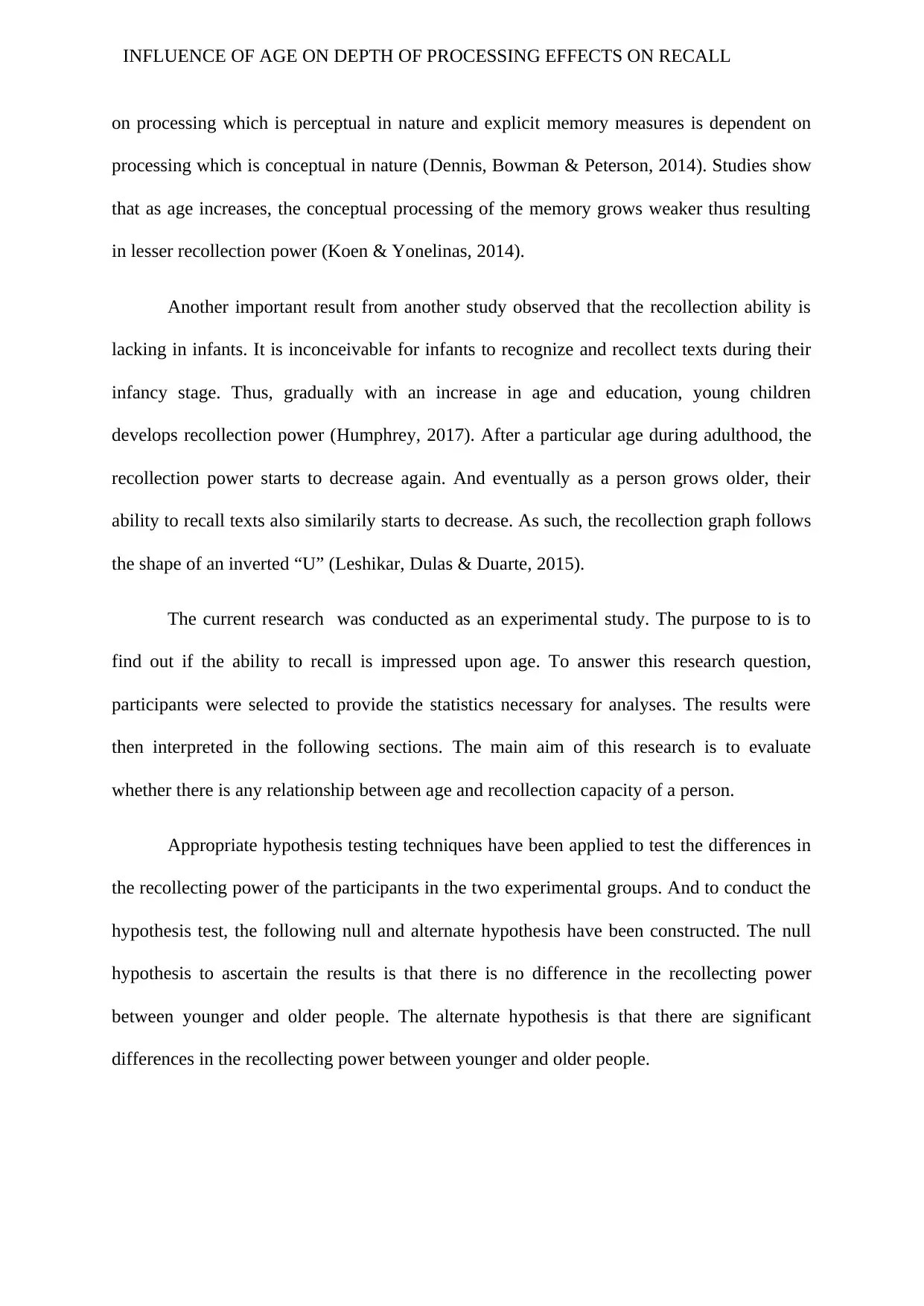
INFLUENCE OF AGE ON DEPTH OF PROCESSING EFFECTS ON RECALL
on processing which is perceptual in nature and explicit memory measures is dependent on
processing which is conceptual in nature (Dennis, Bowman & Peterson, 2014). Studies show
that as age increases, the conceptual processing of the memory grows weaker thus resulting
in lesser recollection power (Koen & Yonelinas, 2014).
Another important result from another study observed that the recollection ability is
lacking in infants. It is inconceivable for infants to recognize and recollect texts during their
infancy stage. Thus, gradually with an increase in age and education, young children
develops recollection power (Humphrey, 2017). After a particular age during adulthood, the
recollection power starts to decrease again. And eventually as a person grows older, their
ability to recall texts also similarily starts to decrease. As such, the recollection graph follows
the shape of an inverted “U” (Leshikar, Dulas & Duarte, 2015).
The current research was conducted as an experimental study. The purpose to is to
find out if the ability to recall is impressed upon age. To answer this research question,
participants were selected to provide the statistics necessary for analyses. The results were
then interpreted in the following sections. The main aim of this research is to evaluate
whether there is any relationship between age and recollection capacity of a person.
Appropriate hypothesis testing techniques have been applied to test the differences in
the recollecting power of the participants in the two experimental groups. And to conduct the
hypothesis test, the following null and alternate hypothesis have been constructed. The null
hypothesis to ascertain the results is that there is no difference in the recollecting power
between younger and older people. The alternate hypothesis is that there are significant
differences in the recollecting power between younger and older people.
on processing which is perceptual in nature and explicit memory measures is dependent on
processing which is conceptual in nature (Dennis, Bowman & Peterson, 2014). Studies show
that as age increases, the conceptual processing of the memory grows weaker thus resulting
in lesser recollection power (Koen & Yonelinas, 2014).
Another important result from another study observed that the recollection ability is
lacking in infants. It is inconceivable for infants to recognize and recollect texts during their
infancy stage. Thus, gradually with an increase in age and education, young children
develops recollection power (Humphrey, 2017). After a particular age during adulthood, the
recollection power starts to decrease again. And eventually as a person grows older, their
ability to recall texts also similarily starts to decrease. As such, the recollection graph follows
the shape of an inverted “U” (Leshikar, Dulas & Duarte, 2015).
The current research was conducted as an experimental study. The purpose to is to
find out if the ability to recall is impressed upon age. To answer this research question,
participants were selected to provide the statistics necessary for analyses. The results were
then interpreted in the following sections. The main aim of this research is to evaluate
whether there is any relationship between age and recollection capacity of a person.
Appropriate hypothesis testing techniques have been applied to test the differences in
the recollecting power of the participants in the two experimental groups. And to conduct the
hypothesis test, the following null and alternate hypothesis have been constructed. The null
hypothesis to ascertain the results is that there is no difference in the recollecting power
between younger and older people. The alternate hypothesis is that there are significant
differences in the recollecting power between younger and older people.
Paraphrase This Document
Need a fresh take? Get an instant paraphrase of this document with our AI Paraphraser
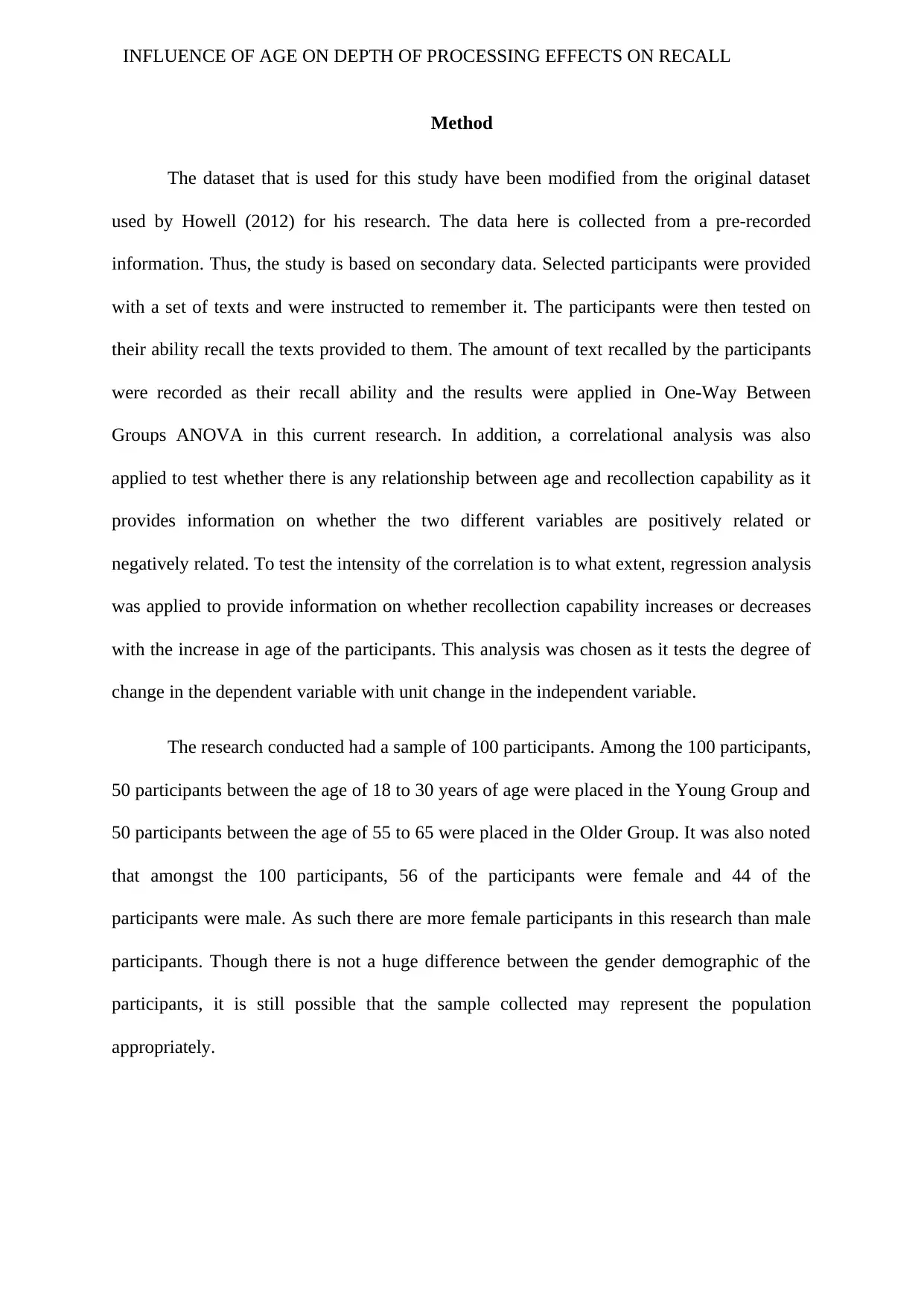
INFLUENCE OF AGE ON DEPTH OF PROCESSING EFFECTS ON RECALL
Method
The dataset that is used for this study have been modified from the original dataset
used by Howell (2012) for his research. The data here is collected from a pre-recorded
information. Thus, the study is based on secondary data. Selected participants were provided
with a set of texts and were instructed to remember it. The participants were then tested on
their ability recall the texts provided to them. The amount of text recalled by the participants
were recorded as their recall ability and the results were applied in One-Way Between
Groups ANOVA in this current research. In addition, a correlational analysis was also
applied to test whether there is any relationship between age and recollection capability as it
provides information on whether the two different variables are positively related or
negatively related. To test the intensity of the correlation is to what extent, regression analysis
was applied to provide information on whether recollection capability increases or decreases
with the increase in age of the participants. This analysis was chosen as it tests the degree of
change in the dependent variable with unit change in the independent variable.
The research conducted had a sample of 100 participants. Among the 100 participants,
50 participants between the age of 18 to 30 years of age were placed in the Young Group and
50 participants between the age of 55 to 65 were placed in the Older Group. It was also noted
that amongst the 100 participants, 56 of the participants were female and 44 of the
participants were male. As such there are more female participants in this research than male
participants. Though there is not a huge difference between the gender demographic of the
participants, it is still possible that the sample collected may represent the population
appropriately.
Method
The dataset that is used for this study have been modified from the original dataset
used by Howell (2012) for his research. The data here is collected from a pre-recorded
information. Thus, the study is based on secondary data. Selected participants were provided
with a set of texts and were instructed to remember it. The participants were then tested on
their ability recall the texts provided to them. The amount of text recalled by the participants
were recorded as their recall ability and the results were applied in One-Way Between
Groups ANOVA in this current research. In addition, a correlational analysis was also
applied to test whether there is any relationship between age and recollection capability as it
provides information on whether the two different variables are positively related or
negatively related. To test the intensity of the correlation is to what extent, regression analysis
was applied to provide information on whether recollection capability increases or decreases
with the increase in age of the participants. This analysis was chosen as it tests the degree of
change in the dependent variable with unit change in the independent variable.
The research conducted had a sample of 100 participants. Among the 100 participants,
50 participants between the age of 18 to 30 years of age were placed in the Young Group and
50 participants between the age of 55 to 65 were placed in the Older Group. It was also noted
that amongst the 100 participants, 56 of the participants were female and 44 of the
participants were male. As such there are more female participants in this research than male
participants. Though there is not a huge difference between the gender demographic of the
participants, it is still possible that the sample collected may represent the population
appropriately.
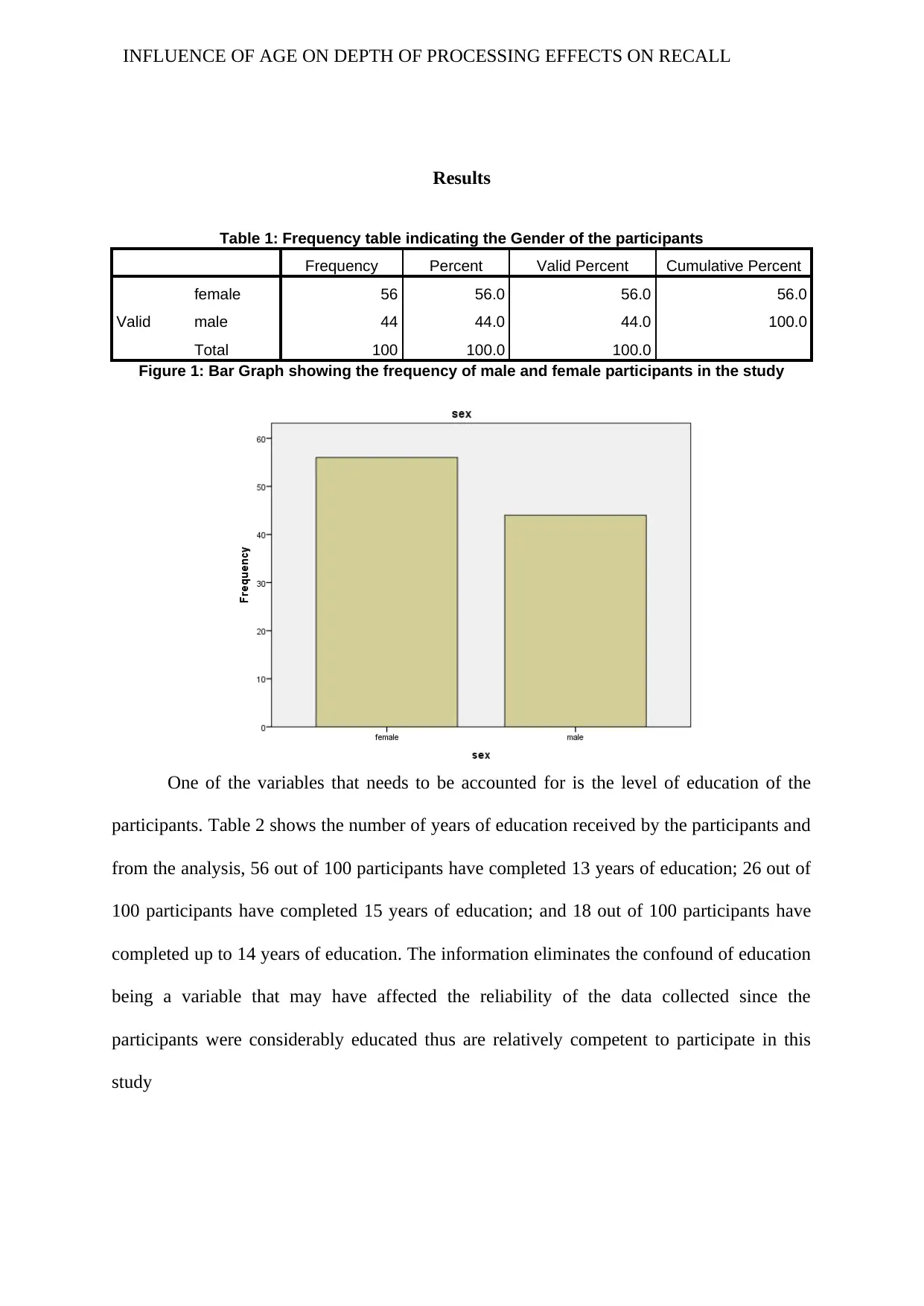
INFLUENCE OF AGE ON DEPTH OF PROCESSING EFFECTS ON RECALL
Results
Table 1: Frequency table indicating the Gender of the participants
Frequency Percent Valid Percent Cumulative Percent
Valid
female 56 56.0 56.0 56.0
male 44 44.0 44.0 100.0
Total 100 100.0 100.0
Figure 1: Bar Graph showing the frequency of male and female participants in the study
One of the variables that needs to be accounted for is the level of education of the
participants. Table 2 shows the number of years of education received by the participants and
from the analysis, 56 out of 100 participants have completed 13 years of education; 26 out of
100 participants have completed 15 years of education; and 18 out of 100 participants have
completed up to 14 years of education. The information eliminates the confound of education
being a variable that may have affected the reliability of the data collected since the
participants were considerably educated thus are relatively competent to participate in this
study
Results
Table 1: Frequency table indicating the Gender of the participants
Frequency Percent Valid Percent Cumulative Percent
Valid
female 56 56.0 56.0 56.0
male 44 44.0 44.0 100.0
Total 100 100.0 100.0
Figure 1: Bar Graph showing the frequency of male and female participants in the study
One of the variables that needs to be accounted for is the level of education of the
participants. Table 2 shows the number of years of education received by the participants and
from the analysis, 56 out of 100 participants have completed 13 years of education; 26 out of
100 participants have completed 15 years of education; and 18 out of 100 participants have
completed up to 14 years of education. The information eliminates the confound of education
being a variable that may have affected the reliability of the data collected since the
participants were considerably educated thus are relatively competent to participate in this
study
⊘ This is a preview!⊘
Do you want full access?
Subscribe today to unlock all pages.

Trusted by 1+ million students worldwide
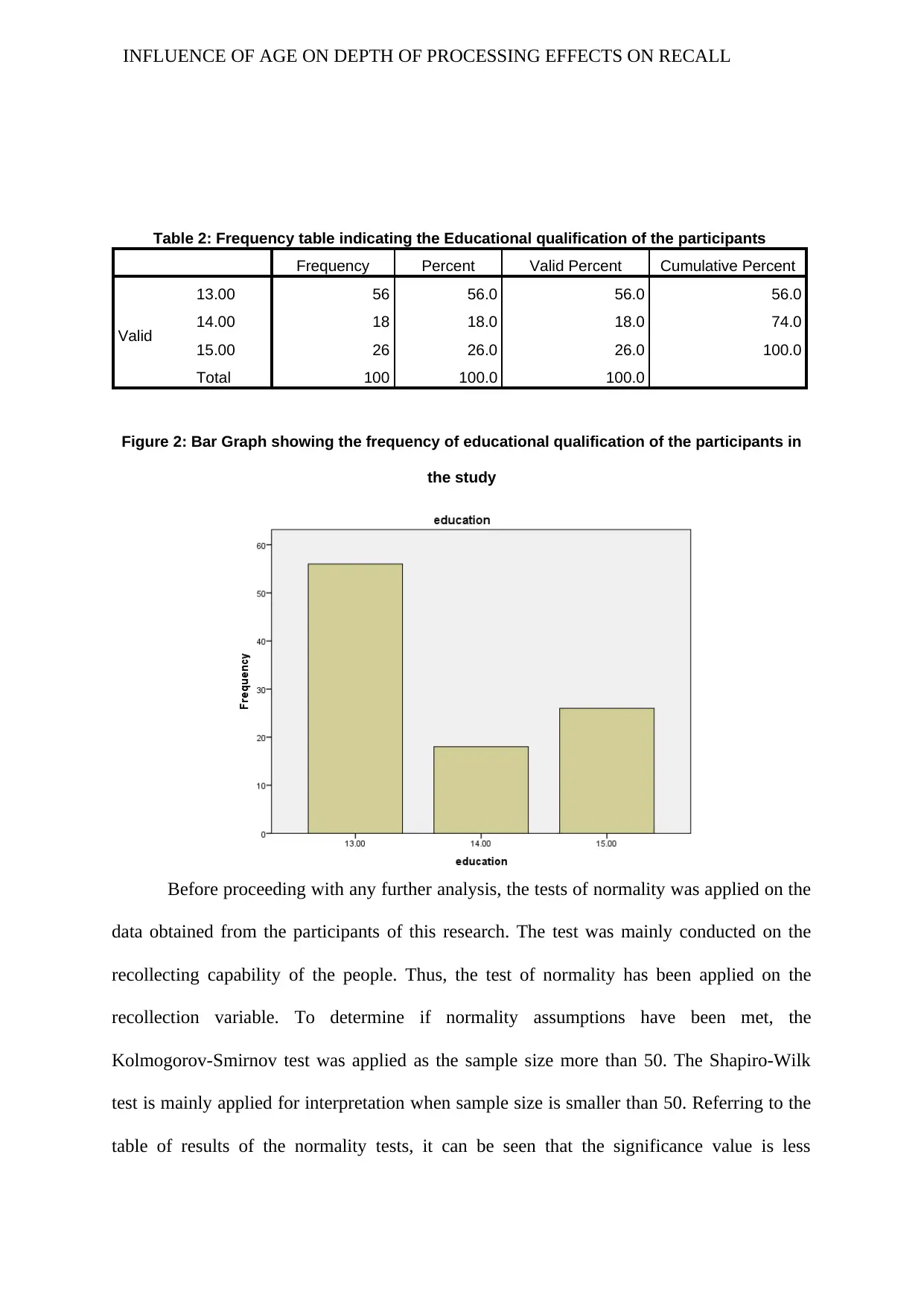
INFLUENCE OF AGE ON DEPTH OF PROCESSING EFFECTS ON RECALL
Table 2: Frequency table indicating the Educational qualification of the participants
Frequency Percent Valid Percent Cumulative Percent
Valid
13.00 56 56.0 56.0 56.0
14.00 18 18.0 18.0 74.0
15.00 26 26.0 26.0 100.0
Total 100 100.0 100.0
Figure 2: Bar Graph showing the frequency of educational qualification of the participants in
the study
Before proceeding with any further analysis, the tests of normality was applied on the
data obtained from the participants of this research. The test was mainly conducted on the
recollecting capability of the people. Thus, the test of normality has been applied on the
recollection variable. To determine if normality assumptions have been met, the
Kolmogorov-Smirnov test was applied as the sample size more than 50. The Shapiro-Wilk
test is mainly applied for interpretation when sample size is smaller than 50. Referring to the
table of results of the normality tests, it can be seen that the significance value is less
Table 2: Frequency table indicating the Educational qualification of the participants
Frequency Percent Valid Percent Cumulative Percent
Valid
13.00 56 56.0 56.0 56.0
14.00 18 18.0 18.0 74.0
15.00 26 26.0 26.0 100.0
Total 100 100.0 100.0
Figure 2: Bar Graph showing the frequency of educational qualification of the participants in
the study
Before proceeding with any further analysis, the tests of normality was applied on the
data obtained from the participants of this research. The test was mainly conducted on the
recollecting capability of the people. Thus, the test of normality has been applied on the
recollection variable. To determine if normality assumptions have been met, the
Kolmogorov-Smirnov test was applied as the sample size more than 50. The Shapiro-Wilk
test is mainly applied for interpretation when sample size is smaller than 50. Referring to the
table of results of the normality tests, it can be seen that the significance value is less
Paraphrase This Document
Need a fresh take? Get an instant paraphrase of this document with our AI Paraphraser
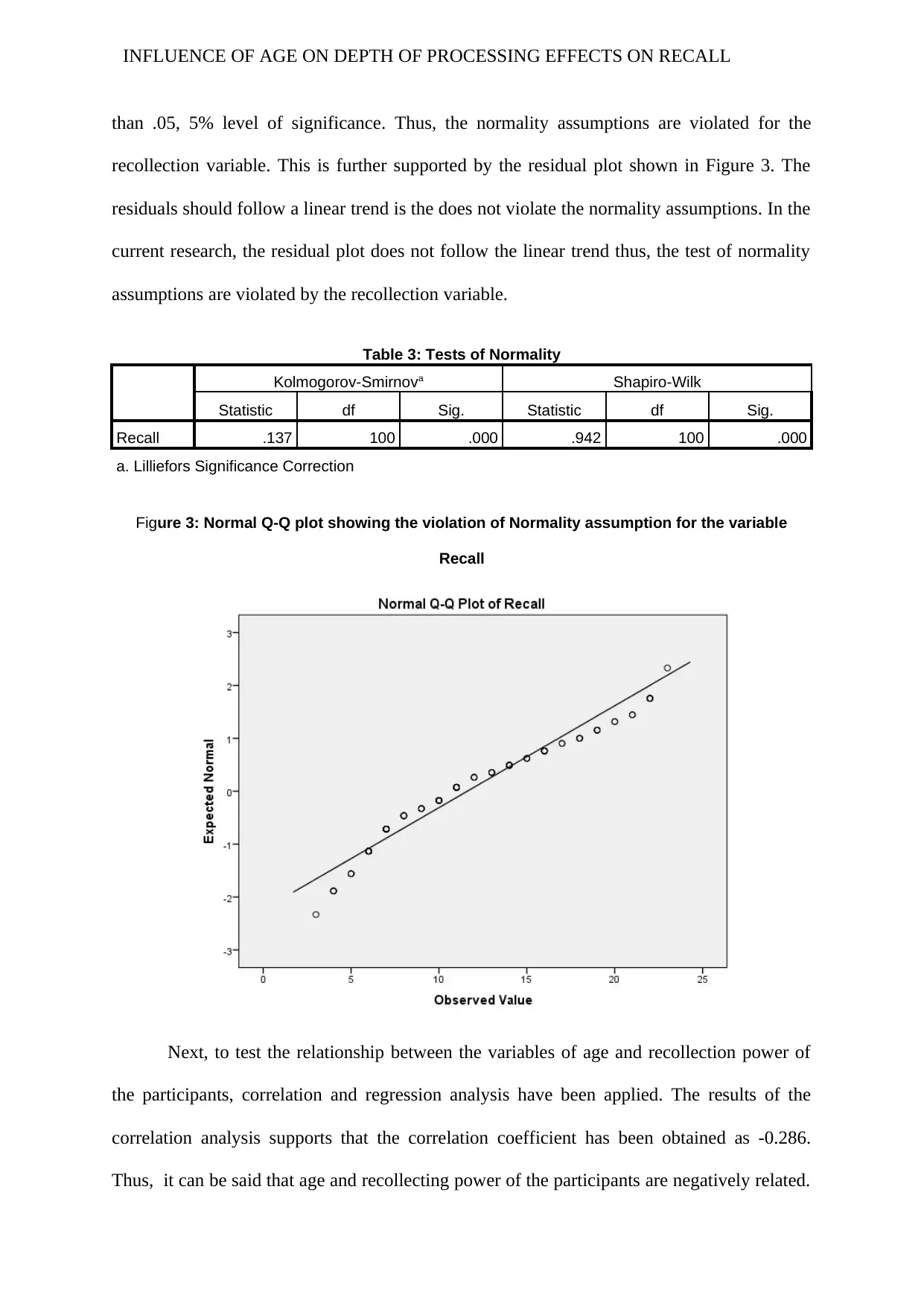
INFLUENCE OF AGE ON DEPTH OF PROCESSING EFFECTS ON RECALL
than .05, 5% level of significance. Thus, the normality assumptions are violated for the
recollection variable. This is further supported by the residual plot shown in Figure 3. The
residuals should follow a linear trend is the does not violate the normality assumptions. In the
current research, the residual plot does not follow the linear trend thus, the test of normality
assumptions are violated by the recollection variable.
Table 3: Tests of Normality
Kolmogorov-Smirnova Shapiro-Wilk
Statistic df Sig. Statistic df Sig.
Recall .137 100 .000 .942 100 .000
a. Lilliefors Significance Correction
Figure 3: Normal Q-Q plot showing the violation of Normality assumption for the variable
Recall
Next, to test the relationship between the variables of age and recollection power of
the participants, correlation and regression analysis have been applied. The results of the
correlation analysis supports that the correlation coefficient has been obtained as -0.286.
Thus, it can be said that age and recollecting power of the participants are negatively related.
than .05, 5% level of significance. Thus, the normality assumptions are violated for the
recollection variable. This is further supported by the residual plot shown in Figure 3. The
residuals should follow a linear trend is the does not violate the normality assumptions. In the
current research, the residual plot does not follow the linear trend thus, the test of normality
assumptions are violated by the recollection variable.
Table 3: Tests of Normality
Kolmogorov-Smirnova Shapiro-Wilk
Statistic df Sig. Statistic df Sig.
Recall .137 100 .000 .942 100 .000
a. Lilliefors Significance Correction
Figure 3: Normal Q-Q plot showing the violation of Normality assumption for the variable
Recall
Next, to test the relationship between the variables of age and recollection power of
the participants, correlation and regression analysis have been applied. The results of the
correlation analysis supports that the correlation coefficient has been obtained as -0.286.
Thus, it can be said that age and recollecting power of the participants are negatively related.
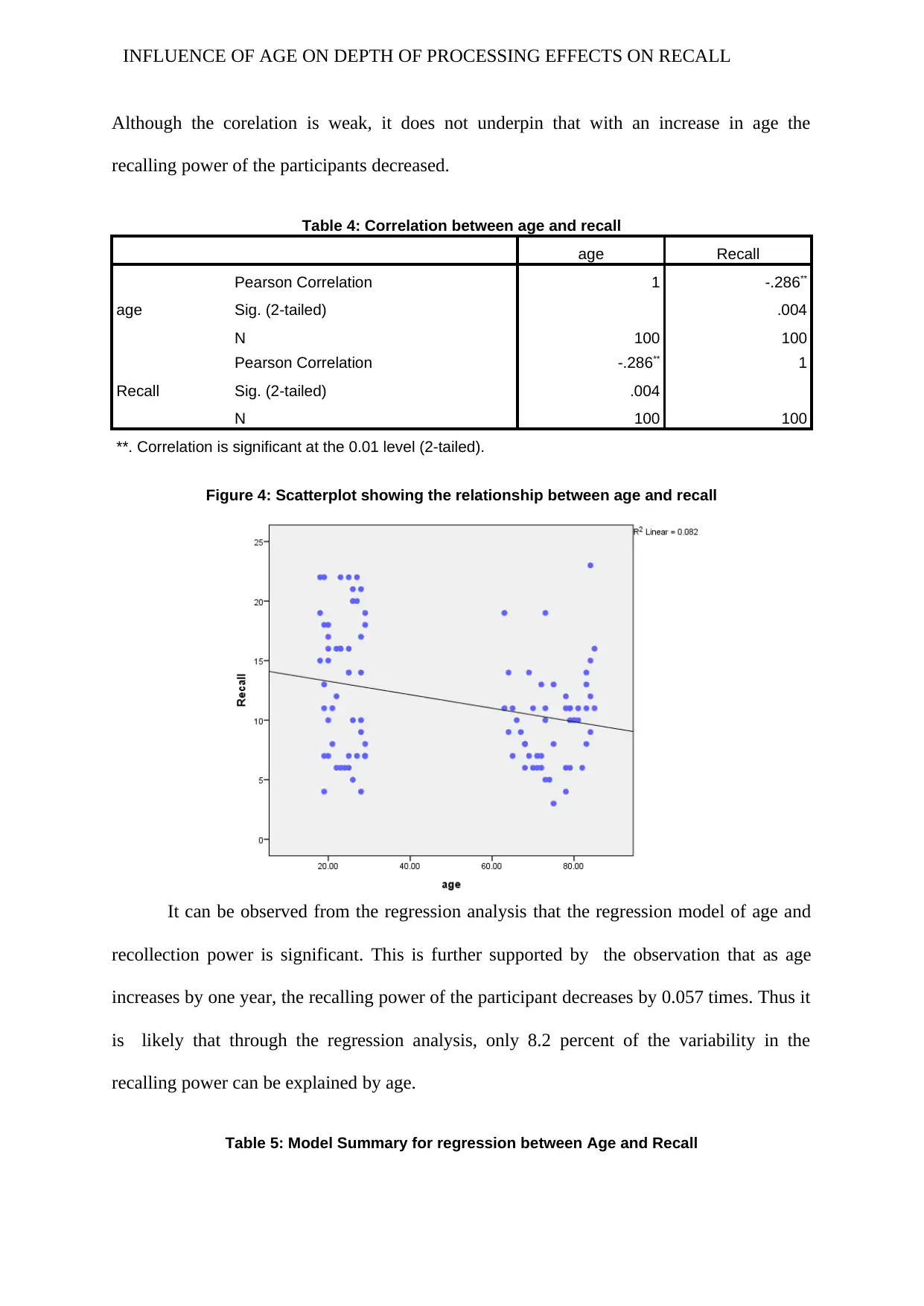
INFLUENCE OF AGE ON DEPTH OF PROCESSING EFFECTS ON RECALL
Although the corelation is weak, it does not underpin that with an increase in age the
recalling power of the participants decreased.
Table 4: Correlation between age and recall
age Recall
age
Pearson Correlation 1 -.286**
Sig. (2-tailed) .004
N 100 100
Recall
Pearson Correlation -.286** 1
Sig. (2-tailed) .004
N 100 100
**. Correlation is significant at the 0.01 level (2-tailed).
Figure 4: Scatterplot showing the relationship between age and recall
It can be observed from the regression analysis that the regression model of age and
recollection power is significant. This is further supported by the observation that as age
increases by one year, the recalling power of the participant decreases by 0.057 times. Thus it
is likely that through the regression analysis, only 8.2 percent of the variability in the
recalling power can be explained by age.
Table 5: Model Summary for regression between Age and Recall
Although the corelation is weak, it does not underpin that with an increase in age the
recalling power of the participants decreased.
Table 4: Correlation between age and recall
age Recall
age
Pearson Correlation 1 -.286**
Sig. (2-tailed) .004
N 100 100
Recall
Pearson Correlation -.286** 1
Sig. (2-tailed) .004
N 100 100
**. Correlation is significant at the 0.01 level (2-tailed).
Figure 4: Scatterplot showing the relationship between age and recall
It can be observed from the regression analysis that the regression model of age and
recollection power is significant. This is further supported by the observation that as age
increases by one year, the recalling power of the participant decreases by 0.057 times. Thus it
is likely that through the regression analysis, only 8.2 percent of the variability in the
recalling power can be explained by age.
Table 5: Model Summary for regression between Age and Recall
⊘ This is a preview!⊘
Do you want full access?
Subscribe today to unlock all pages.

Trusted by 1+ million students worldwide
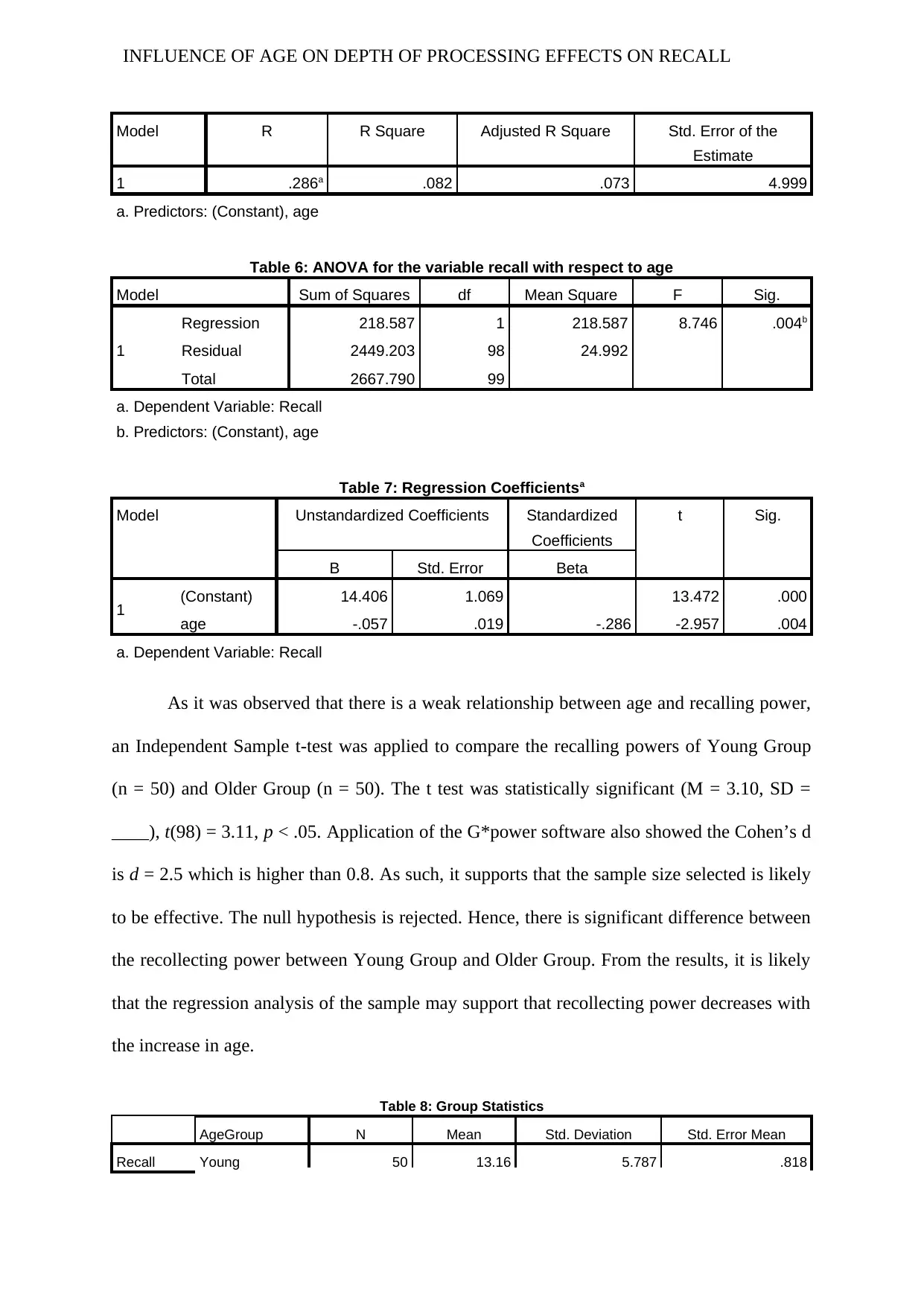
INFLUENCE OF AGE ON DEPTH OF PROCESSING EFFECTS ON RECALL
Model R R Square Adjusted R Square Std. Error of the
Estimate
1 .286a .082 .073 4.999
a. Predictors: (Constant), age
Table 6: ANOVA for the variable recall with respect to age
Model Sum of Squares df Mean Square F Sig.
1
Regression 218.587 1 218.587 8.746 .004b
Residual 2449.203 98 24.992
Total 2667.790 99
a. Dependent Variable: Recall
b. Predictors: (Constant), age
Table 7: Regression Coefficientsa
Model Unstandardized Coefficients Standardized
Coefficients
t Sig.
B Std. Error Beta
1 (Constant) 14.406 1.069 13.472 .000
age -.057 .019 -.286 -2.957 .004
a. Dependent Variable: Recall
As it was observed that there is a weak relationship between age and recalling power,
an Independent Sample t-test was applied to compare the recalling powers of Young Group
(n = 50) and Older Group (n = 50). The t test was statistically significant (M = 3.10, SD =
____), t(98) = 3.11, p < .05. Application of the G*power software also showed the Cohen’s d
is d = 2.5 which is higher than 0.8. As such, it supports that the sample size selected is likely
to be effective. The null hypothesis is rejected. Hence, there is significant difference between
the recollecting power between Young Group and Older Group. From the results, it is likely
that the regression analysis of the sample may support that recollecting power decreases with
the increase in age.
Table 8: Group Statistics
AgeGroup N Mean Std. Deviation Std. Error Mean
Recall Young 50 13.16 5.787 .818
Model R R Square Adjusted R Square Std. Error of the
Estimate
1 .286a .082 .073 4.999
a. Predictors: (Constant), age
Table 6: ANOVA for the variable recall with respect to age
Model Sum of Squares df Mean Square F Sig.
1
Regression 218.587 1 218.587 8.746 .004b
Residual 2449.203 98 24.992
Total 2667.790 99
a. Dependent Variable: Recall
b. Predictors: (Constant), age
Table 7: Regression Coefficientsa
Model Unstandardized Coefficients Standardized
Coefficients
t Sig.
B Std. Error Beta
1 (Constant) 14.406 1.069 13.472 .000
age -.057 .019 -.286 -2.957 .004
a. Dependent Variable: Recall
As it was observed that there is a weak relationship between age and recalling power,
an Independent Sample t-test was applied to compare the recalling powers of Young Group
(n = 50) and Older Group (n = 50). The t test was statistically significant (M = 3.10, SD =
____), t(98) = 3.11, p < .05. Application of the G*power software also showed the Cohen’s d
is d = 2.5 which is higher than 0.8. As such, it supports that the sample size selected is likely
to be effective. The null hypothesis is rejected. Hence, there is significant difference between
the recollecting power between Young Group and Older Group. From the results, it is likely
that the regression analysis of the sample may support that recollecting power decreases with
the increase in age.
Table 8: Group Statistics
AgeGroup N Mean Std. Deviation Std. Error Mean
Recall Young 50 13.16 5.787 .818
Paraphrase This Document
Need a fresh take? Get an instant paraphrase of this document with our AI Paraphraser
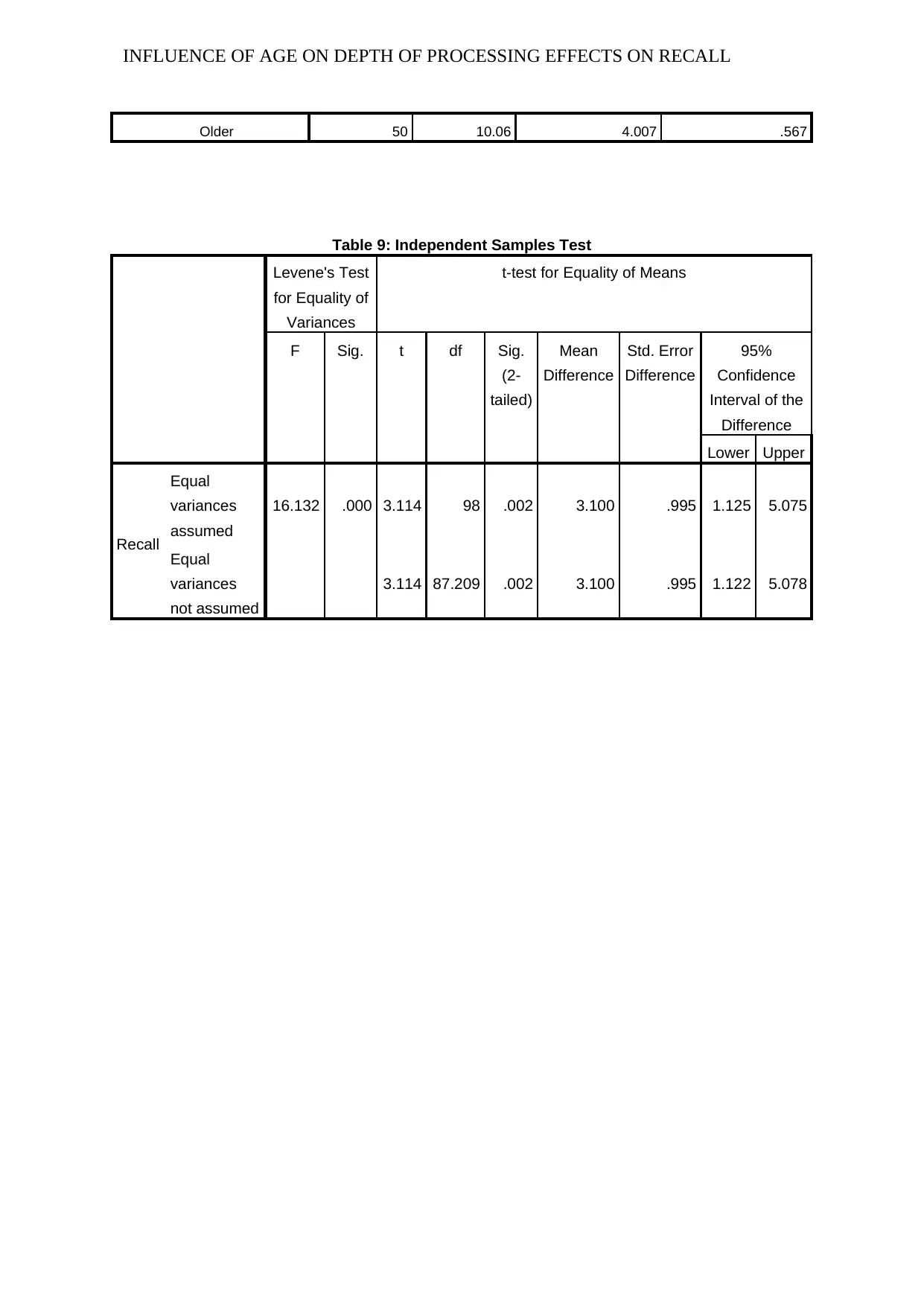
INFLUENCE OF AGE ON DEPTH OF PROCESSING EFFECTS ON RECALL
Older 50 10.06 4.007 .567
Table 9: Independent Samples Test
Levene's Test
for Equality of
Variances
t-test for Equality of Means
F Sig. t df Sig.
(2-
tailed)
Mean
Difference
Std. Error
Difference
95%
Confidence
Interval of the
Difference
Lower Upper
Recall
Equal
variances
assumed
16.132 .000 3.114 98 .002 3.100 .995 1.125 5.075
Equal
variances
not assumed
3.114 87.209 .002 3.100 .995 1.122 5.078
Older 50 10.06 4.007 .567
Table 9: Independent Samples Test
Levene's Test
for Equality of
Variances
t-test for Equality of Means
F Sig. t df Sig.
(2-
tailed)
Mean
Difference
Std. Error
Difference
95%
Confidence
Interval of the
Difference
Lower Upper
Recall
Equal
variances
assumed
16.132 .000 3.114 98 .002 3.100 .995 1.125 5.075
Equal
variances
not assumed
3.114 87.209 .002 3.100 .995 1.122 5.078
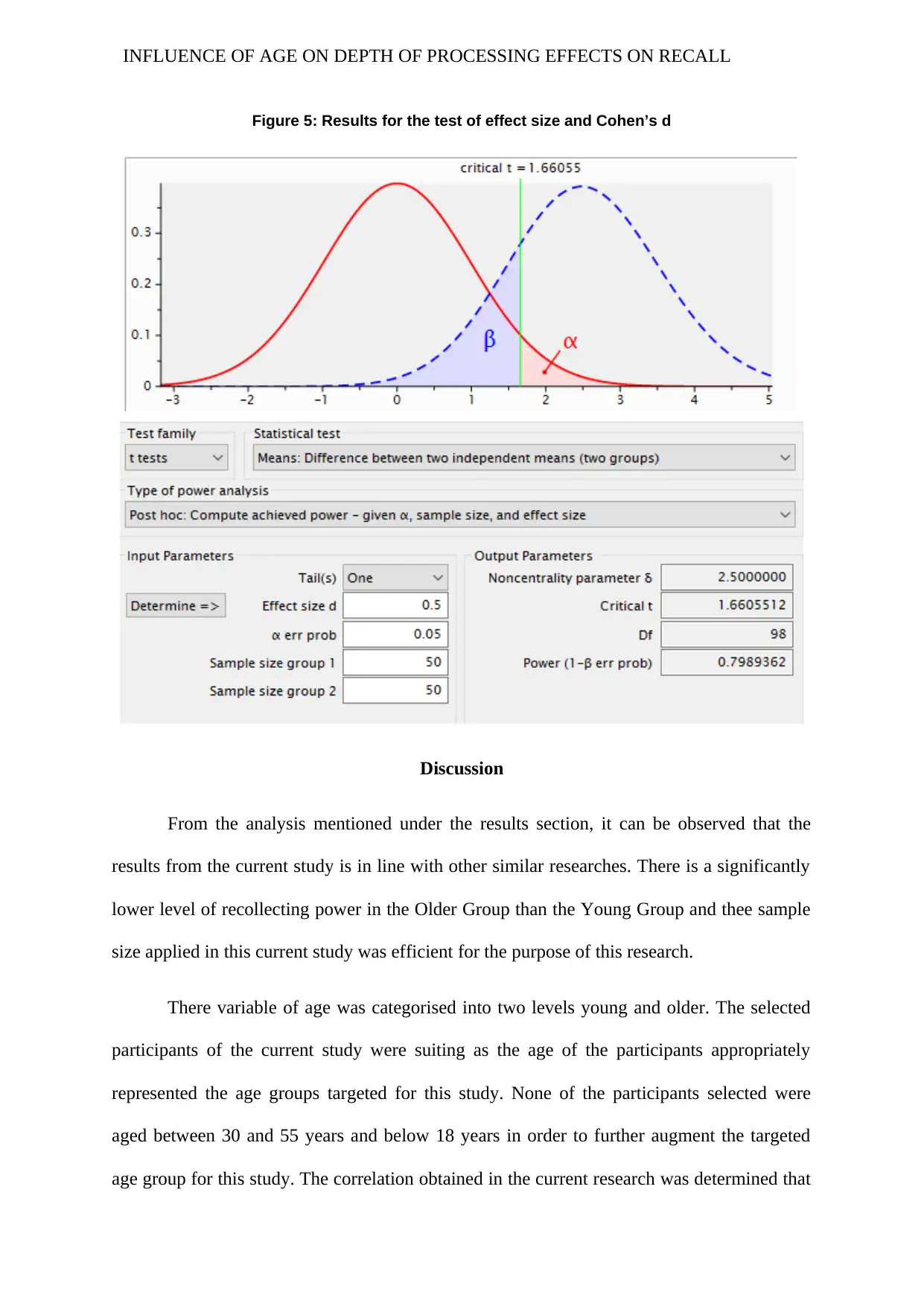
INFLUENCE OF AGE ON DEPTH OF PROCESSING EFFECTS ON RECALL
Figure 5: Results for the test of effect size and Cohen’s d
Discussion
From the analysis mentioned under the results section, it can be observed that the
results from the current study is in line with other similar researches. There is a significantly
lower level of recollecting power in the Older Group than the Young Group and thee sample
size applied in this current study was efficient for the purpose of this research.
There variable of age was categorised into two levels young and older. The selected
participants of the current study were suiting as the age of the participants appropriately
represented the age groups targeted for this study. None of the participants selected were
aged between 30 and 55 years and below 18 years in order to further augment the targeted
age group for this study. The correlation obtained in the current research was determined that
Figure 5: Results for the test of effect size and Cohen’s d
Discussion
From the analysis mentioned under the results section, it can be observed that the
results from the current study is in line with other similar researches. There is a significantly
lower level of recollecting power in the Older Group than the Young Group and thee sample
size applied in this current study was efficient for the purpose of this research.
There variable of age was categorised into two levels young and older. The selected
participants of the current study were suiting as the age of the participants appropriately
represented the age groups targeted for this study. None of the participants selected were
aged between 30 and 55 years and below 18 years in order to further augment the targeted
age group for this study. The correlation obtained in the current research was determined that
⊘ This is a preview!⊘
Do you want full access?
Subscribe today to unlock all pages.

Trusted by 1+ million students worldwide
1 out of 14
Related Documents
Your All-in-One AI-Powered Toolkit for Academic Success.
+13062052269
info@desklib.com
Available 24*7 on WhatsApp / Email
![[object Object]](/_next/static/media/star-bottom.7253800d.svg)
Unlock your academic potential
Copyright © 2020–2025 A2Z Services. All Rights Reserved. Developed and managed by ZUCOL.





